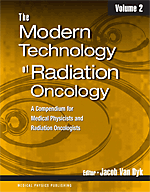
The Modern Technology of Radiation Oncology, Vol 2
Author: Jacob Van Dyk, editorISBN: 9781930524255 ISBN10: 1930524250
Published: 2005 | 514 pp | Hardcover
Price: $ 120.00
Journal of Applied Clinical Medical Physics, Vol. 7, Issue 2 | Spring 2006
The Modern Technology of Radiation Oncology, volume 1, was a compendium of the technology
and techniques and their implementation in modern radiation therapy practice, and was published
in 1999. Since that time, a number of developments and enhancements to the practice of
radiation oncology have been undertaken. The Modern Technology of Radiation Oncology,
volume 2, updates and further details some technologies that were introduced in volume 1; it also
introduces in detail technologies that were too new or nonexistent and not reviewed in volume 1.
For example, Chapter 2, Imaging and Radiation Therapy Planning, is a followup and
enhancement to volume 1's Chapter 7 on a similar topic. Likewise, Chapter 10, Prostate
Brachytherapy, is a detailed expansion of this subject, only introduced in volume 1, Chapter 18.
Overall, this describes the significant incremental advances in radiation therapy technology since
volume 1 was published a few years ago. This book is intended for, and likely useful for, medical
physicists at all levels in their careers, medical physics residents, and, to some extent, medical
residents for some applications. Certain aspects of the book would also be useful for dosimetrists
and radiation therapists in training and during their practice.
Chapter 1 presents the motivating summary for this volume, referring to new technology that
allows higher, more conformal radiation doses to be delivered. Each new technology requires
additional understanding, quality assurance, precision, accuracy, etc. Of great significance in this
very complex technological environment are the issues of quality assurance relative to reducing
errors. It is also important to recognize that new technologies present new challenges, and these
challenges may impact the clinical result. What we do now for new techniques should not be
what we have always done because the risks and failure modes may be different. This at times
requires an assessment to improve the process with new technology, even if it means significant
change.
Chapter 2 updates the reader on imaging for treatment planning. It includes accounting for
motion and four-dimensional scanning as well as updates on MR, PET, PET CT, and SPECT. A
detailed review of the Task Group 66 Report on CT simulation is also included, although it might
be too detailed because TG 66 is a published report.
Chapter 3 is an excellent introduction to Monte Carlo treatment-planning solutions, but it may be
too detailed on some of the technical aspects, which makes locating critical and important
information difficult for the average reader. Good clinical examples are shown.
Chapter 4 is a detailed and thorough description of inverse planning with specific and clinically
meaningful examples. It pays particular attention to the nuances that physicists and dosimetrists
need to understand to effectively use inverse planning algorithms. This includes understanding
how the system behaves with variations in key parameters, objectives, constraints, prioritizations,
and prescriptions. This chapter also goes into a lot of detail rather than leaving anything out.
Chapter 5 is an overview of and introduction to the development of current radiobiological
models and their limitations. It points out the real lack of good experimental data to build reliable
and predictable radiobiological models. The history of the linear quadratic model and the
derivation of tumor control probability and normal tissue complication probabilities are
described. Existing data are reviewed in the context of the models and their limitations. The
authors stress the true complexity in developing a model with minimal data that are meaningful
when extrapolated to radiation therapy treatments.
Chapter 6 presents an update on intensity-modulated radiotherapy (IMRT), but it is somewhat
redundant with Chapter 4 in this volume and Chapter 12 of volume 1. This, to some extent, is
confusing to the reader because the nomenclature is slightly different in this chapter than in the
previous discussions of IMRT. For the reader to jump back and forth between Chapters 4 and 6
of this volume and Chapter 12 of the previous volume is too complex. In addition, the use of
vendor-specific examples may not be generally applicable to all users.
Chapter 7 updates the radiographic verification process and reviews advanced solutions for this
process, namely, image-guided radiation therapy. It includes the essential procedures for the use,
commissioning, and quality assurance of kilovoltage, megavoltage, cone-beam CT, and CT-based methods of localization. It drives home the point that the treatment plan is intended to
deliver a specific dose to the target, and that the verification protocols allow the team to be
certain, through an organized technical process, that the dose was indeed delivered as intended.
Chapter 8 introduces and brings the reader quickly up-to-date on the status of breathing and
breathing control in radiation therapy treatments. This is a very good review of the current state
of respiratory issues and their potential solutions.
Chapter 9 describes the essentials and basics related to the use of ion chambers for absolute
calibration of megavoltage beams. Some of the basics overlap with those already considered in
volume 1 on dose measurement tools, specifically ion chambers. This is, however, a very good
summary of currently applicable calibration protocols. It also underscores, and clearly covers, the
critical importance of quality assurance of calibration procedures.
Chapter 10 updates the brachytherapy practice, specifically for prostate implants, and includes a
current and substantial review of low-dose rate and high-dose rate techniques for prostate
brachytherapy.
In summary, volume 2 of The Modern Technology of Radiation Oncology contains some very
useful information for medical physicists at any stage in their career, for radiation oncology
residents, and for dosimetrists and radiation therapists. Although some of the information is too
detailed and some is redundant with volume 1 and with other chapters of this volume, most
would find this a reference worth having in their library.
Michael G. Herman, Ph.D.
Vice Chairman and Head of Physics
Mayo Clinic
Rochester, MN
